INTRODUCTION
Around 1300 years ago, two sculptors carved two Kannon statues out of a sacred tree. One
of them was enshrined here at Hasedera in Kamakura. It is commonly called “Eleven-headed
Kannon” since it has eleven heads on top of its own head. It measures 9.18 meters tall
and this makes it one of the largest wooden Buddhist statues in Japan.
Hesedera
temple resides on a mountain called “Kannon-zan”. The ground holds a large variety of
flowers which bloom throughout the year welcoming visitors. Additionally, the scenic
view from the observation platform on the upper ground is recognized as one of the most
picturesque spots in Kamakura.
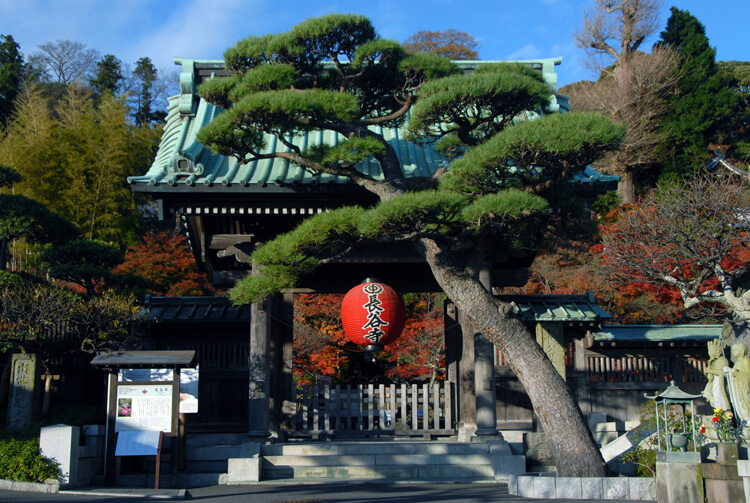
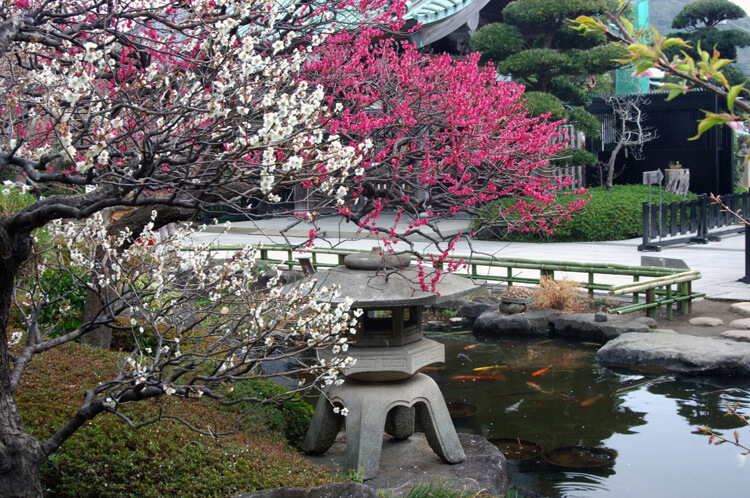
History of Hasedera
According to the legend, in 721 AD, two
Kannon statues were carved out of one sacred tree in Hatsuse (in the present day Nara
Prefecture). One was enshrined at the Hasedera temple in Nara, the other was thrown into
the ocean with a prayer to make it reappear and save people elsewhere. After the Kannon
statue traveled across the waters for fifteen long years, it finally washed ashore in a
place in the present day Kanagawa Prefecture. In 736 AD, the Hasedera temple in Kamakura
was established to enshrine the Kannon statue.
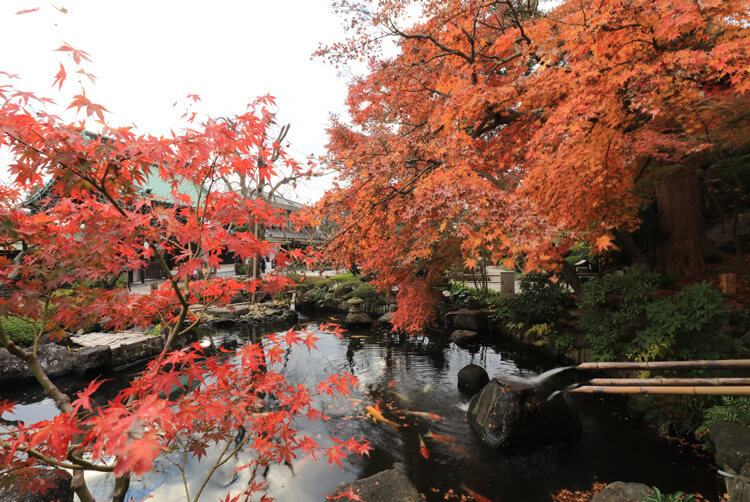
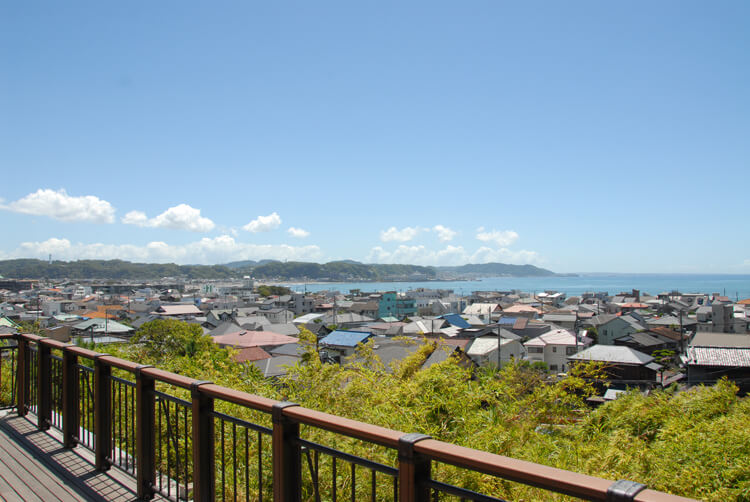
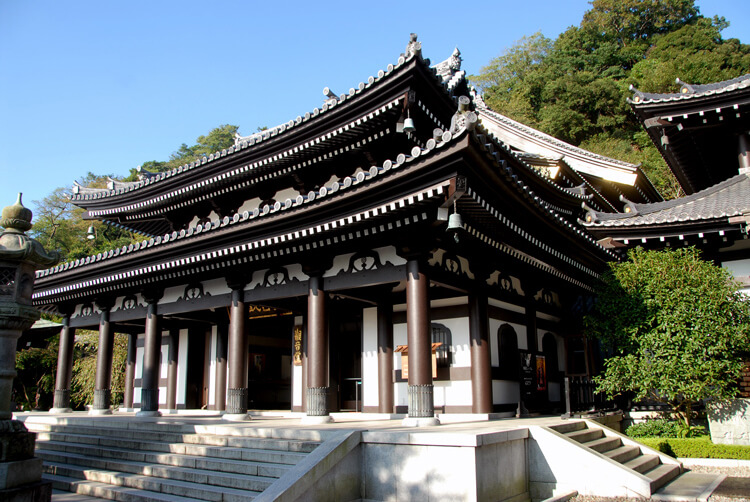
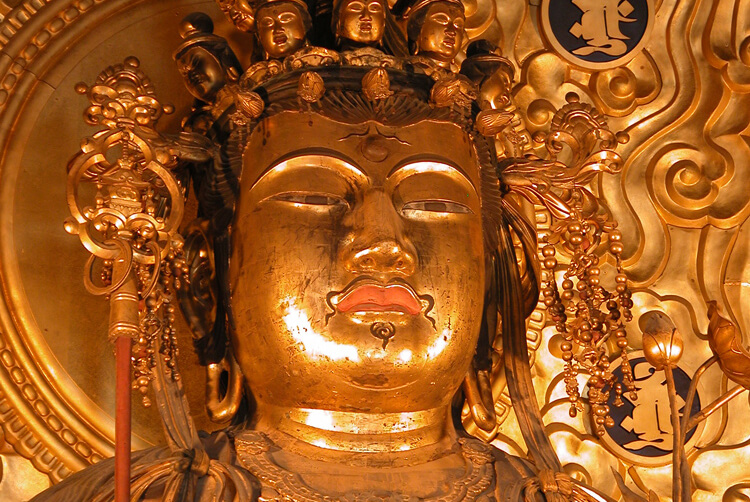
Map of Hasedera
Please click to see more details

Main Gate
The gate is the forth largest of its kind in Kamakura. A symbolic large red lantern and gate-shading pine tree welcome the visitors.

Entrance (Ticket Office)
Please purchase your admission tickets here. Electronic money (Suica / Pasmo cards) can be used at the ticket vending machines. Adults: 400 yen / Children: 200 yen

Benten-do Hall
Fukutoku-benzaiten, known as the Goddess of music and wisdom is enshrined inside the hall. It is believed to dispel misfortunes and to give answers to prayers for developing technical skills.

Benten-do Hall
Fukutoku-benzaiten, known as the Goddess of music and wisdom is enshrined inside the hall. It is believed to dispel misfortunes and to give answers to prayers for developing technical skills.
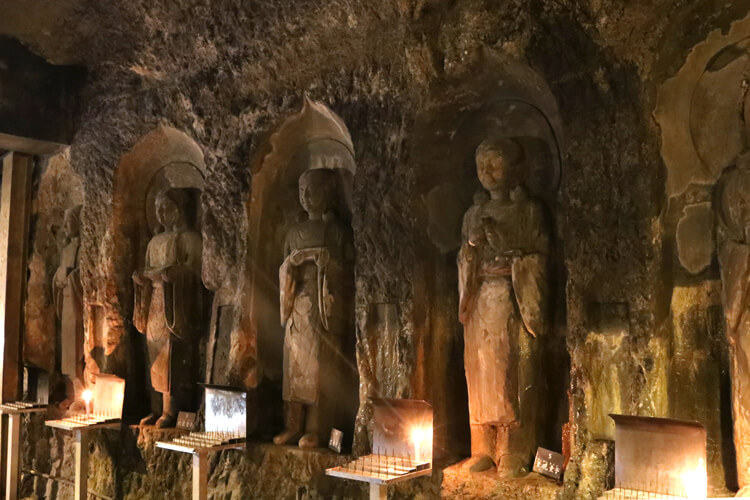
Benten-kutsu Cave
This is believed to be the place where Kobo Daishi, the Japanese Buddhist saint practiced in seclusion. Benzaiten and her followers of the Sixteen Children are chiseled out of the rock walls in one of the chambers inside the cave. Small statues called Hono Benzaiten can be placed to offer in the last chamber. Visitors can give a prayer by writing their wish and name on the statue and leave it there as an offering.
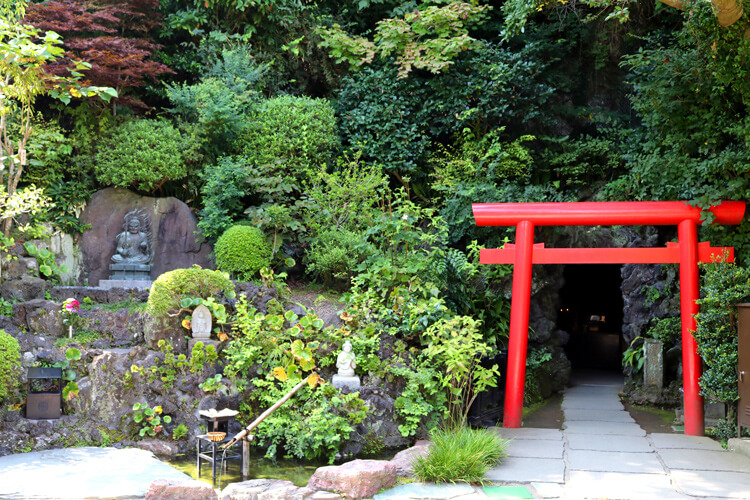
Benten-kutsu Cave
This is believed to be the place where Kobo Daishi, the Japanese Buddhist saint practiced in seclusion. Benzaiten and her followers of the Sixteen Children are chiseled out of the rock walls in one of the chambers inside the cave. Small statues called Hono Benzaiten can be placed to offer in the last chamber. Visitors can give a prayer by writing their wish and name on the statue and leave it there as an offering.
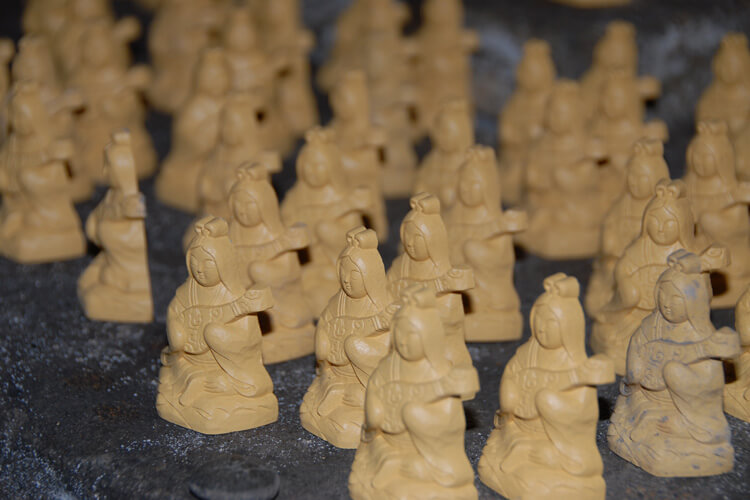
Benten-kutsu Cave
This is believed to be the place where Kobo Daishi, the Japanese Buddhist saint practiced in seclusion. Benzaiten and her followers of the Sixteen Children are chiseled out of the rock walls in one of the chambers inside the cave. Small statues called Hono Benzaiten can be placed to offer in the last chamber. Visitors can give a prayer by writing their wish and name on the statue and leave it there as an offering.
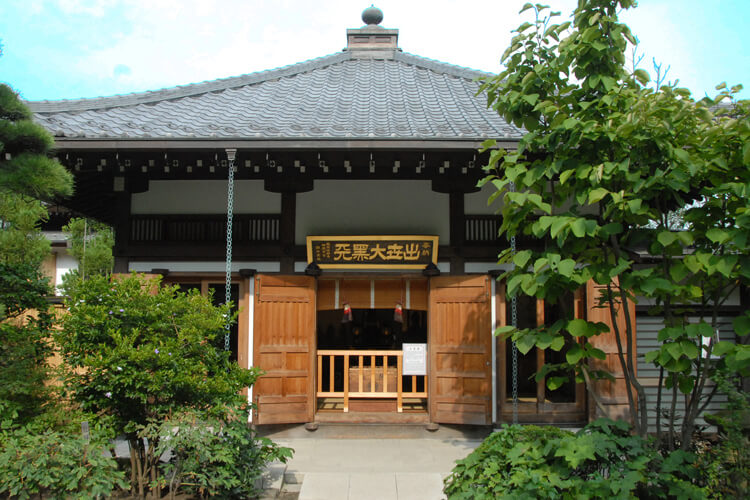
Daikoku-do Hall
The original statue of Daikokuten, which was carved in 1412, is the oldest of its type in Kanagawa Prefecture (exhibited only on special occasions). The current enshrined Daikokuten is believed to give success in life and business. Additionally Sawari Daikoku, which visitors are able to touch to receive good fortune is housed here as well.
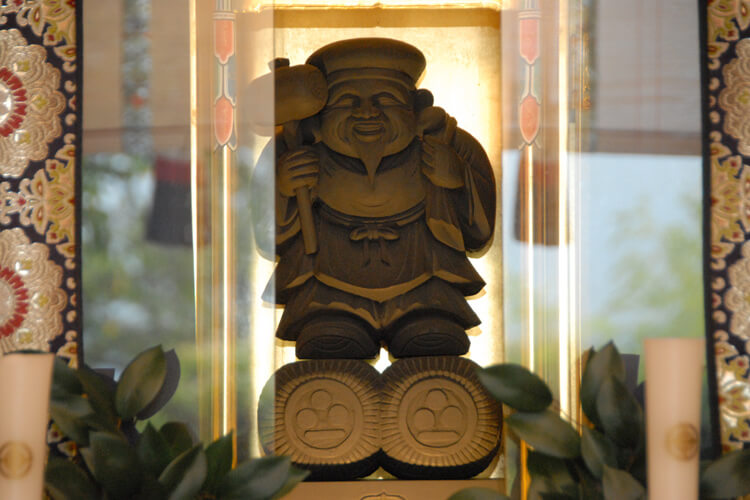
Daikoku-do Hall
The original statue of Daikokuten, which was carved in 1412, is the oldest of its type in Kanagawa Prefecture (exhibited only on special occasions). The current enshrined Daikokuten is believed to give success in life and business. Additionally Sawari Daikoku, which visitors are able to touch to receive good fortune is housed here as well.
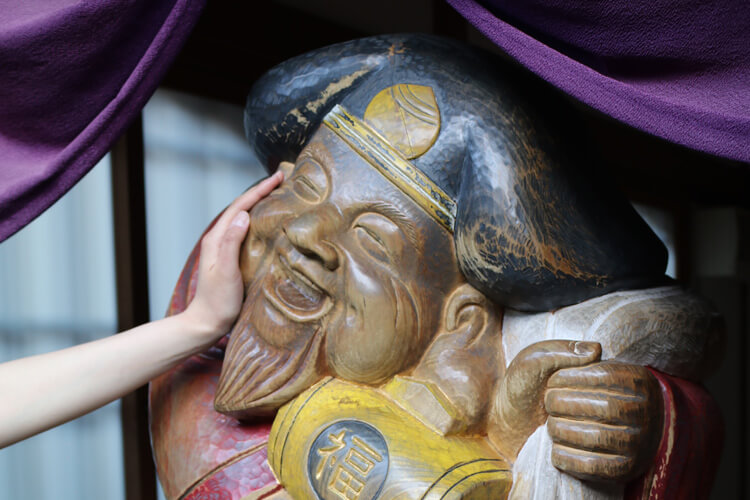
Daikoku-do Hall
The original statue of Daikokuten, which was carved in 1412, is the oldest of its type in Kanagawa Prefecture (exhibited only on special occasions). The current enshrined Daikokuten is believed to give success in life and business. Additionally Sawari Daikoku, which visitors are able to touch to receive good fortune is housed here as well.
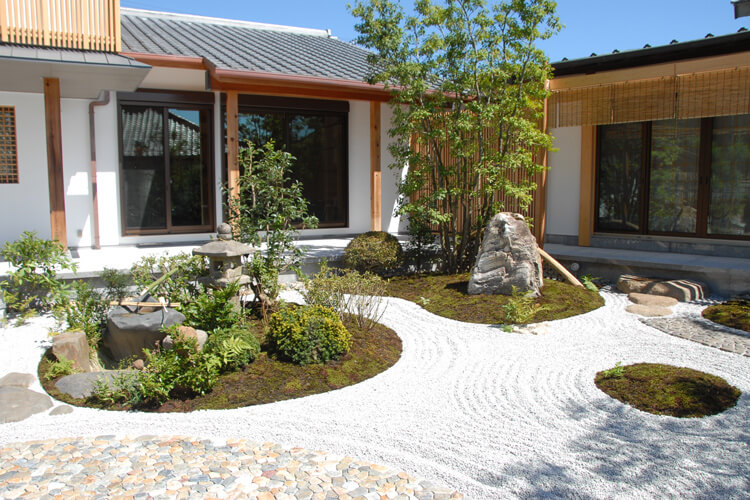
Shoin Hall (Shakyo Plactice Room)
Shoin hall has a shakyo practice room in which visitors can copy sutras
as a part of their Buddhist practice. →More
A Karesansui garden
or Japanese rock garden sits in front of the hall. This exquisite garden is a kind of
traditional Japanese garden. It represents streams without the use of water but with rocks
and small stones, the lines drawn by small rocks express the flow of water.
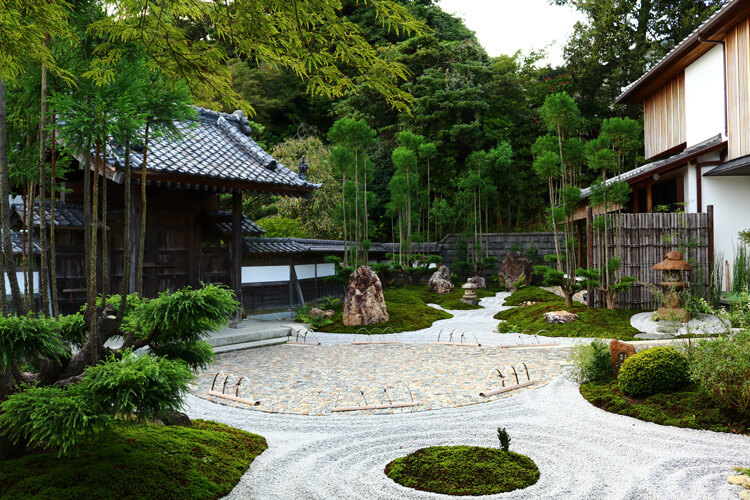
Shoin Hall (Shakyo Plactice Room)
Shoin hall has a shakyo practice room in which visitors can copy sutras
as a part of their Buddhist practice. →More
A Karesansui garden
or Japanese rock garden sits in front of the hall. This exquisite garden is a kind of
traditional Japanese garden. It represents streams without the use of water but with rocks
and small stones, the lines drawn by small rocks express the flow of water.
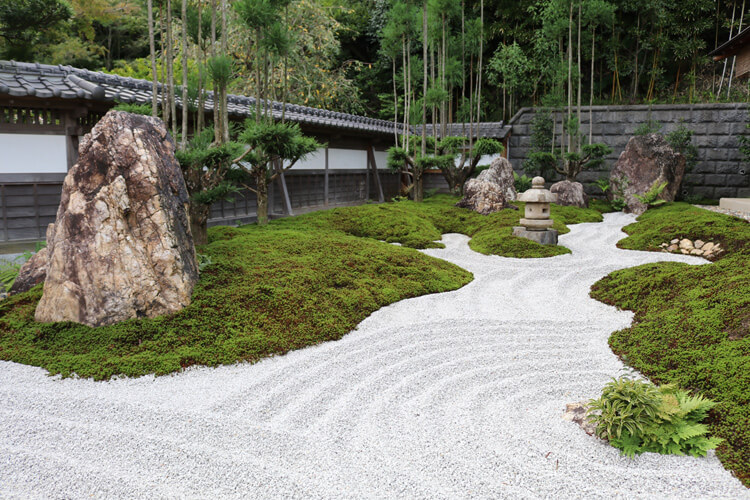
Shoin Hall (Shakyo Plactice Room)
Shoin hall has a shakyo practice room in which visitors can copy sutras
as a part of their Buddhist practice. →More
A Karesansui garden
or Japanese rock garden sits in front of the hall. This exquisite garden is a kind of
traditional Japanese garden. It represents streams without the use of water but with rocks
and small stones, the lines drawn by small rocks express the flow of water.
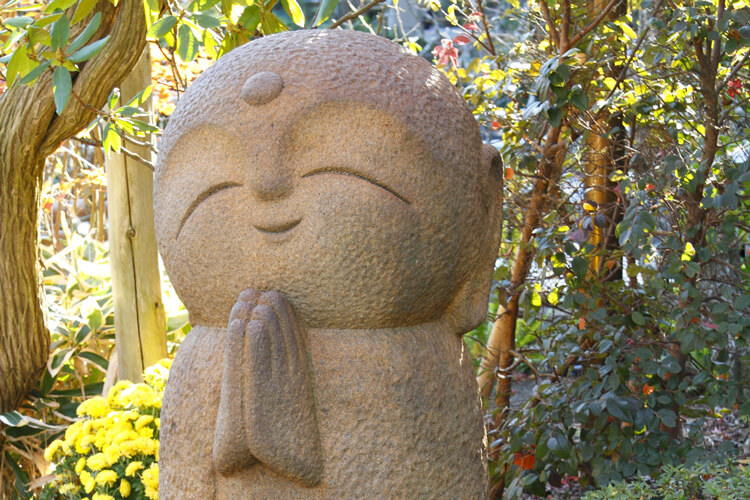
Nagomi Jizo
This Nagomi Jizo statue was placed to give a peace of mind to visitors in 2010. It is also a popular photo-spot as you can be in a picture with the smiling Nagomi Jizo.
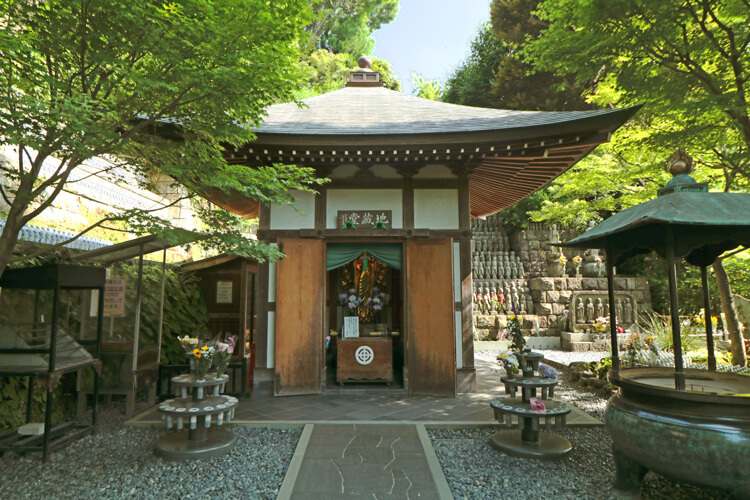
Jizo-do Hall
The hall appears after taking the stairs from the lower level. Surrounding the hall, a large number of Jizo statues called Sentai Jizo or Thousand Jizo stand in long rows. Jizo is a Buddhist deity believed to protect children and give prosperity to one’s descendant. Mizukake Jizo (water-pouring Jizo) is placed near the hall as well. It is believed that one can purify one’s mind by gently pouring water over the statue.
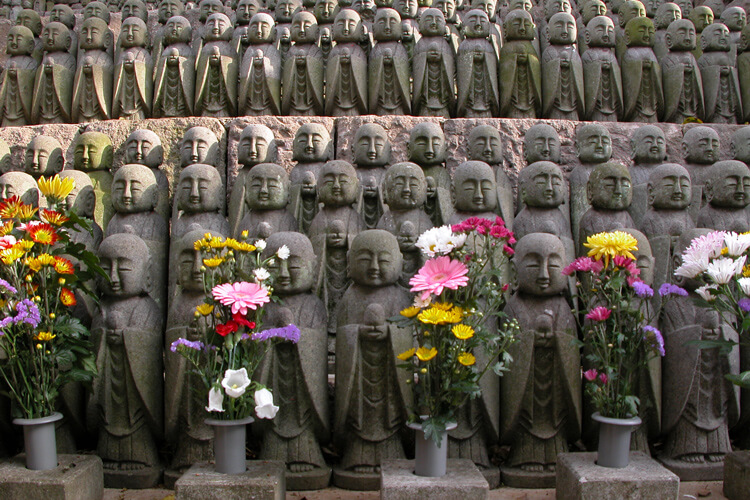
Jizo-do Hall
The hall appears after taking the stairs from the lower level. Surrounding the hall, a large number of Jizo statues called Sentai Jizo or Thousand Jizo stand in long rows. Jizo is a Buddhist deity believed to protect children and give prosperity to one’s descendant. Mizukake Jizo (water-pouring Jizo) is placed near the hall as well. It is believed that one can purify one’s mind by gently pouring water over the statue.
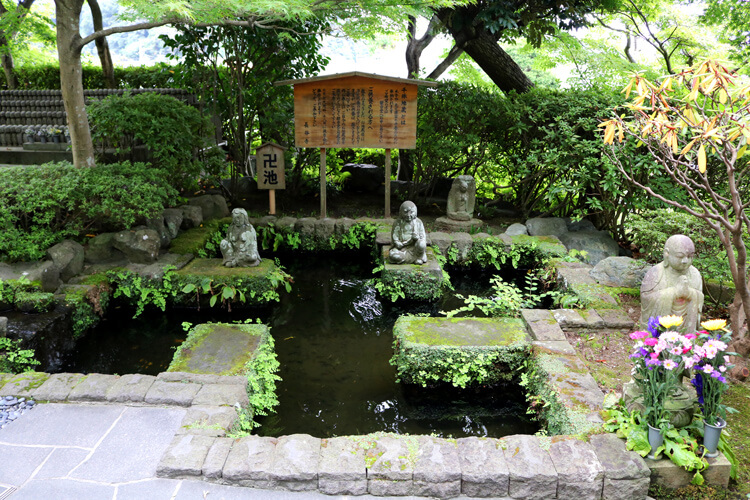
Jizo-do Hall
The hall appears after taking the stairs from the lower level. Surrounding the hall, a large number of Jizo statues called Sentai Jizo or Thousand Jizo stand in long rows. Jizo is a Buddhist deity believed to protect children and give prosperity to one’s descendant. Mizukake Jizo (water-pouring Jizo) is placed near the hall as well. It is believed that one can purify one’s mind by gently pouring water over the statue.
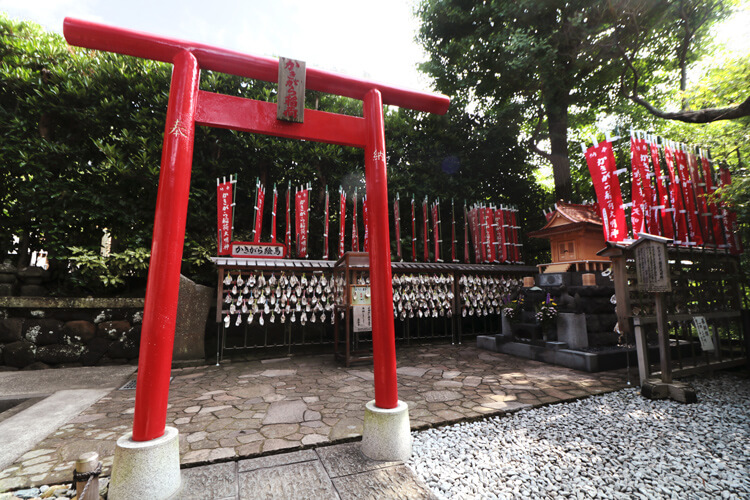
Inari-sha (Kakigara-inari)
This shrine is found with many red flags on the side. It was established to enshrine Kakigara (oyster shells) to receive the divine guidance of Kannon. According to the legend, it has been told that Kakigara protected the Kannon statue when drifting across the sea, as they attached to the statue and guided Kannon to the shore.
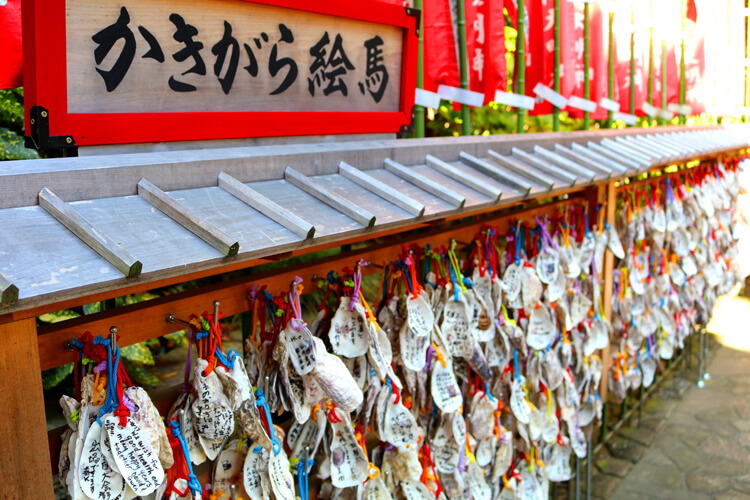
Inari-sha (Kakigara-inari)
This shrine is found with many red flags on the side. It was established to enshrine Kakigara (oyster shells) to receive the divine guidance of Kannon. According to the legend, it has been told that Kakigara protected the Kannon statue when drifting across the sea, as they attached to the statue and guided Kannon to the shore.
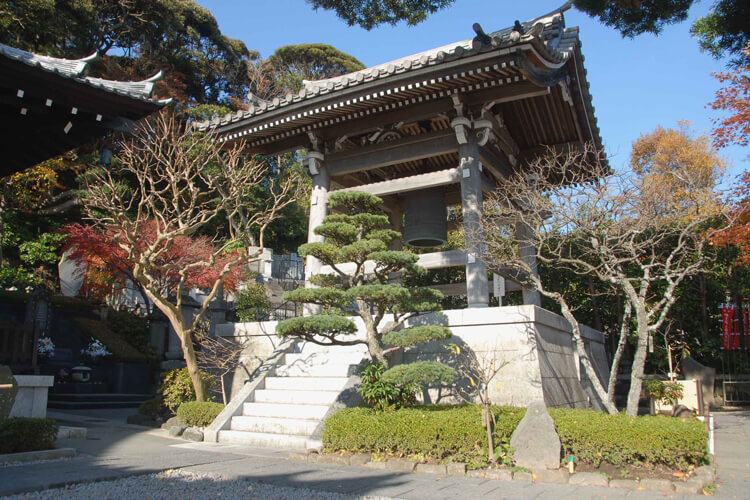
Shoro Belfry
The original bell which was casted in 1264 is the third oldest bell in Kamakura. It was designated as an Important Cultural Property of Japan in 1953, and is currently exhibited in the Kannon Museum. The present temple bell was newly casted in 1984. It is struck at 8 O’clock every morning when the entrance gate opens.
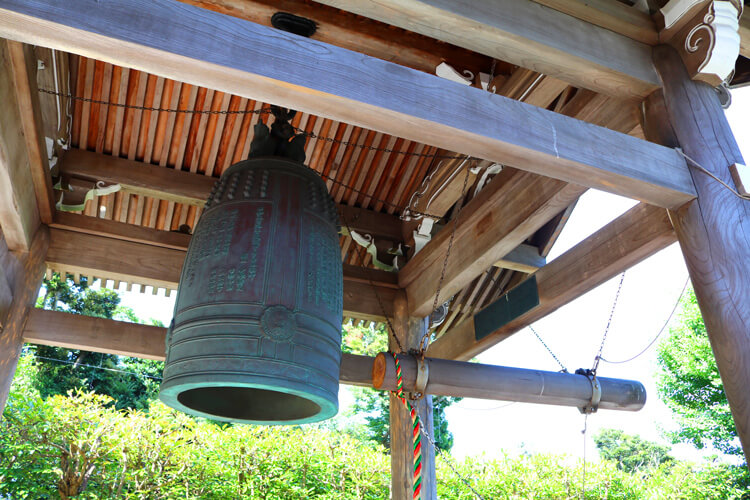
Shoro Belfry
The original bell which was casted in 1264 is the third oldest bell in Kamakura. It was designated as an Important Cultural Property of Japan in 1953, and is currently exhibited in the Kannon Museum. The present temple bell was newly casted in 1984. It is struck at 8 O’clock every morning when the entrance gate opens.
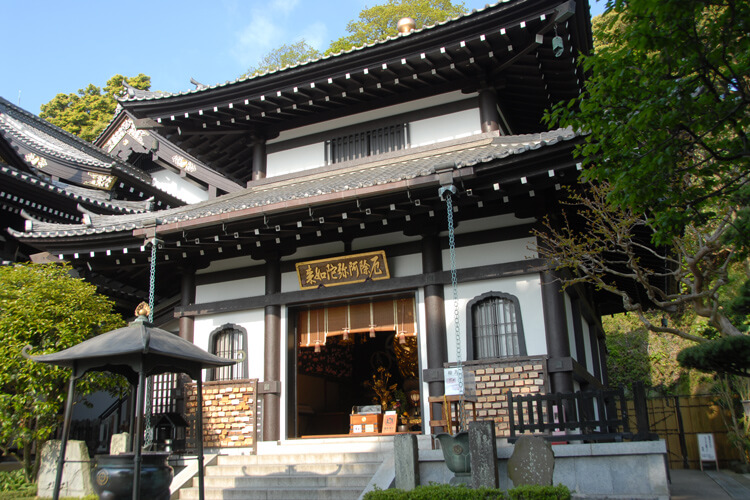
Amida-do Hall
The Amida statue in the hall is told to be carved to ward off evil for
Minamoto no Yoritomo, who was the first shogun of the Kamakura shogunate of Japan. It has
been called Yakuyoke Amida or Amida of expelling evil spirits and misfortune in later
years.
This Amida statue represents one of Kamakura’s Six Amida. In addition, a large
mokugyo (temple’s wood block to sound when chanting) sits inside the hall. It measures 105
cm in width, which makes it the largest mokugyo in Japan.
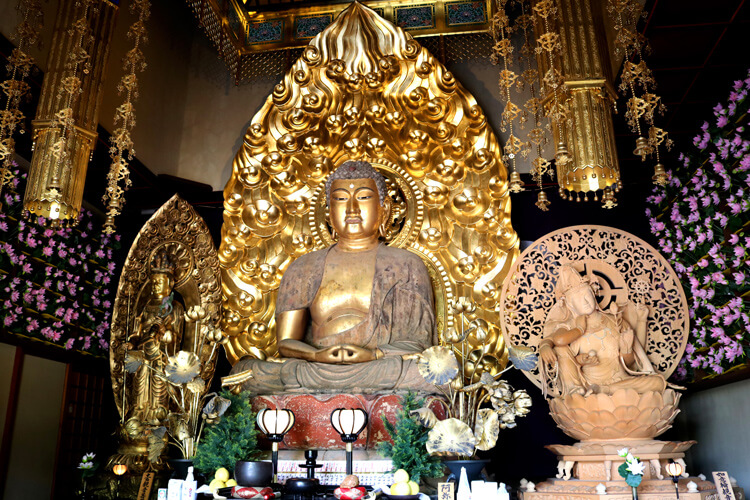
Amida-do Hall
The Amida statue in the hall is told to be carved to ward off evil for
Minamoto no Yoritomo, who was the first shogun of the Kamakura shogunate of Japan. It has
been called Yakuyoke Amida or Amida of expelling evil spirits and misfortune in later
years.
This Amida statue represents one of Kamakura’s Six Amida. In addition, a large
mokugyo (temple’s wood block to sound when chanting) sits inside the hall. It measures 105
cm in width, which makes it the largest mokugyo in Japan.
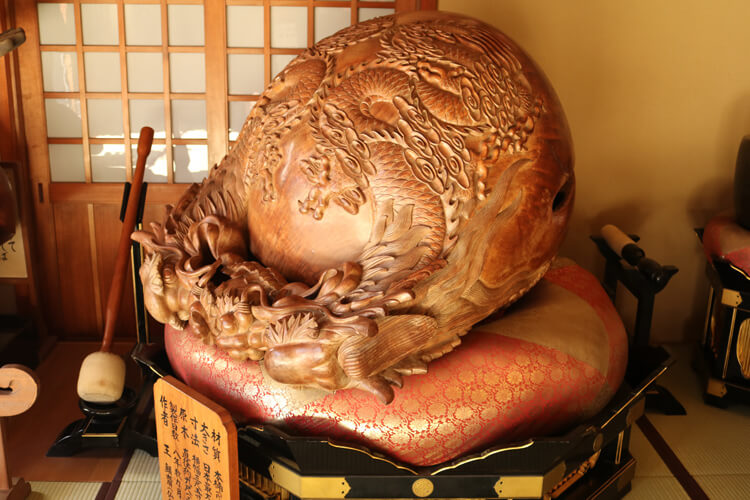
Amida-do Hall
The Amida statue in the hall is told to be carved to ward off evil for
Minamoto no Yoritomo, who was the first shogun of the Kamakura shogunate of Japan. It has
been called Yakuyoke Amida or Amida of expelling evil spirits and misfortune in later
years.
This Amida statue represents one of Kamakura’s Six Amida. In addition, a large
mokugyo (temple’s wood block to sound when chanting) sits inside the hall. It measures 105
cm in width, which makes it the largest mokugyo in Japan.
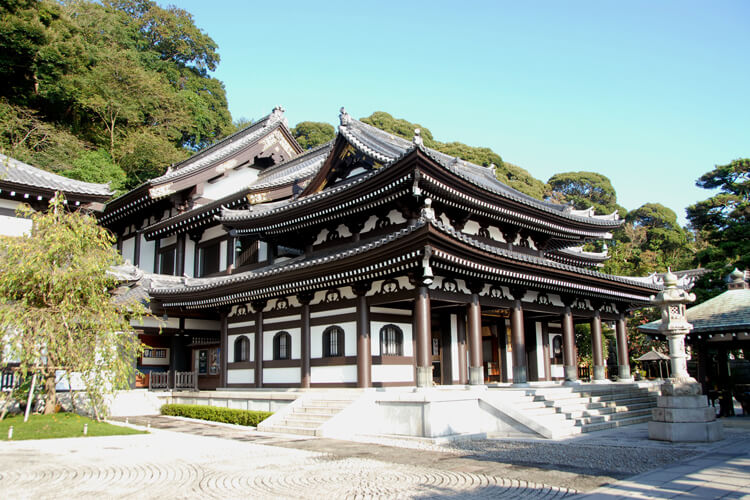
Kannon-do Hall
(Exterior) According to the legend, the original Kannon-do hall was established in 736, when the Kannon statue washed ashore. Although it has been reconstructed a number of times in later years, one time experiencing the Great Kanto Earthquake in 1923 the hall became devastated. The present Kannon-do hall was built of reinforced concrete to enshrine the Kannon statue protectively. The total reconstruction was finally completed in 1985, after more than 60 years since the disaster.
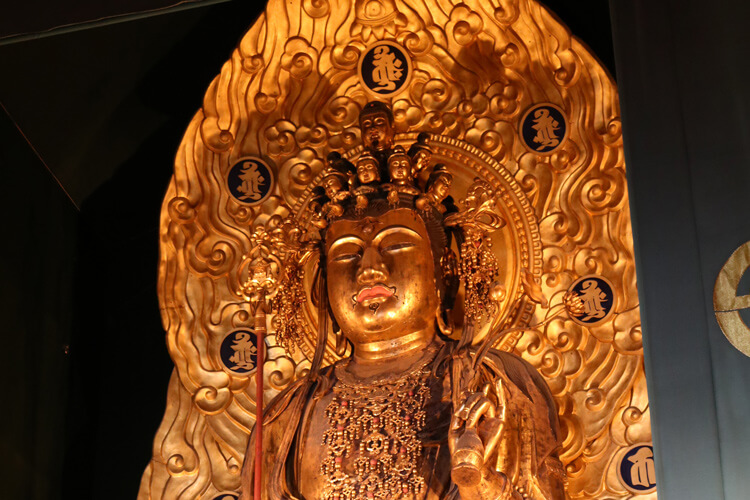
Kannon-do Hall
(Kannon) According to the legend, about 1300 years ago, two Kannon
statues were carved out of a sacred tree in Hatsuse in the present day Nara Prefecture. One
of the Kannon statues was enshrined at the Hasedera temple in Nara, the other was thrown
into the sea with a prayer to reappear and save people elsewhere. After Kannon’s journey of
fifteen long years, it finally washed ashore in a place in the present day Kanagawa
Prefecture. Then it was brought up here to the Hasedera temple in Kamakura.
The Kannon
statue is 9.18 meters tall and this makes it one of the largest wooden Buddhist statues in
Japan. It has eleven heads on top of its own head. It is commonly called Jyu-ichi-men
Kannon, or eleven-headed Kannon.
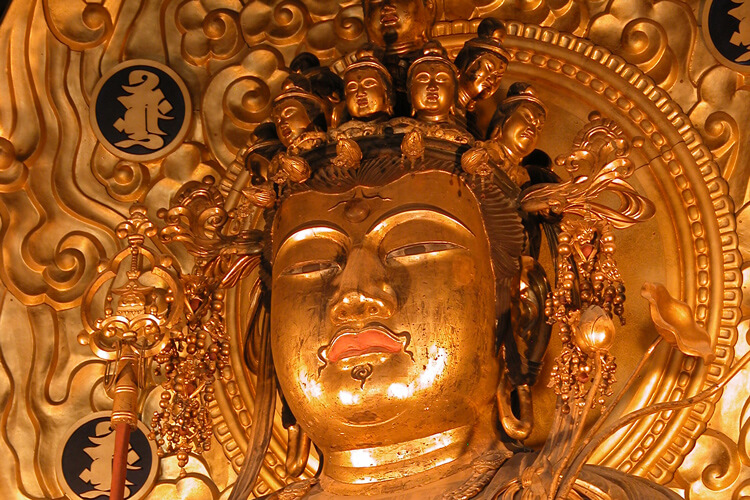
Kannon-do Hall
(Kannon) According to the legend, about 1300 years ago, two Kannon
statues were carved out of a sacred tree in Hatsuse in the present day Nara Prefecture. One
of the Kannon statues was enshrined at the Hasedera temple in Nara, the other was thrown
into the sea with a prayer to reappear and save people elsewhere. After Kannon’s journey of
fifteen long years, it finally washed ashore in a place in the present day Kanagawa
Prefecture. Then it was brought up here to the Hasedera temple in Kamakura.
The Kannon
statue is 9.18 meters tall and this makes it one of the largest wooden Buddhist statues in
Japan. It has eleven heads on top of its own head. It is commonly called Jyu-ichi-men
Kannon, or eleven-headed Kannon.
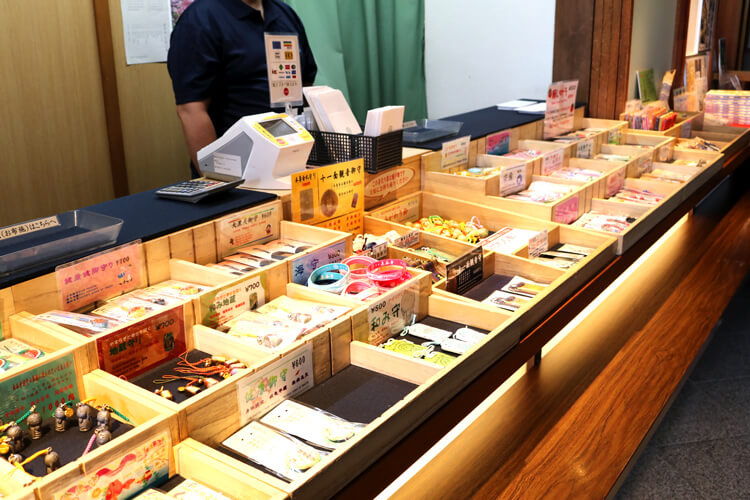
Kannon-do Hall
(Entrance) A counter with charms is found on the left side right after the entrance. Visitors can purchase charms here.
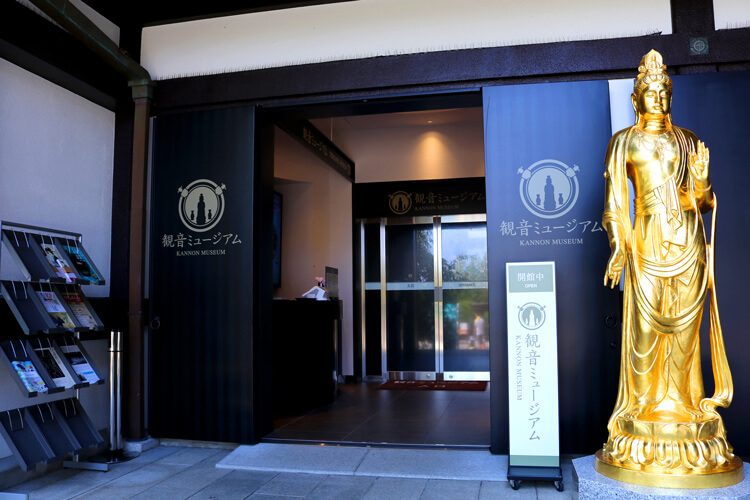
Kannon Museum
The museum exhibits valued historic treasures of Hasedera temple. It
consists of three exhibition spaces. A large digital screen and touch screens are there for
the visitors to acquire better knowledge of Kannon and its faith. Adults: 300 yen /
Children: 150 yen (Closes occasionally between exhibitions)
→ to the Kannon
Museum Website
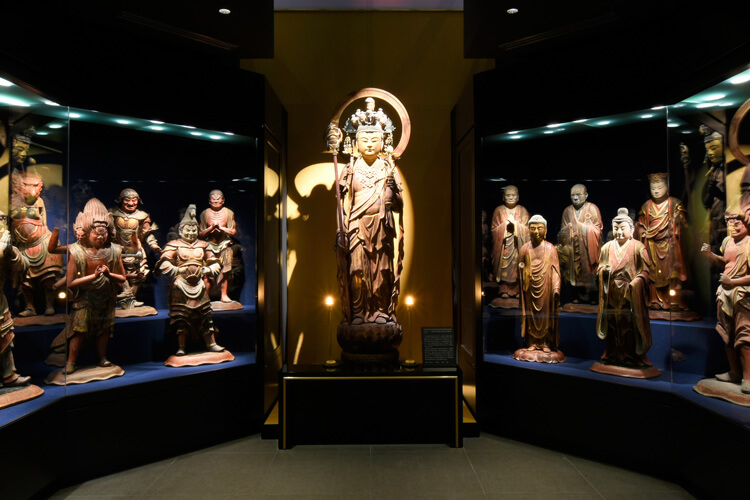
Kannon Museum
The museum exhibits valued historic treasures of Hasedera temple. It
consists of three exhibition spaces. A large digital screen and touch screens are there for
the visitors to acquire better knowledge of Kannon and its faith. Adults: 300 yen /
Children: 150 yen (Closes occasionally between exhibitions)
→ to the Kannon
Museum Website
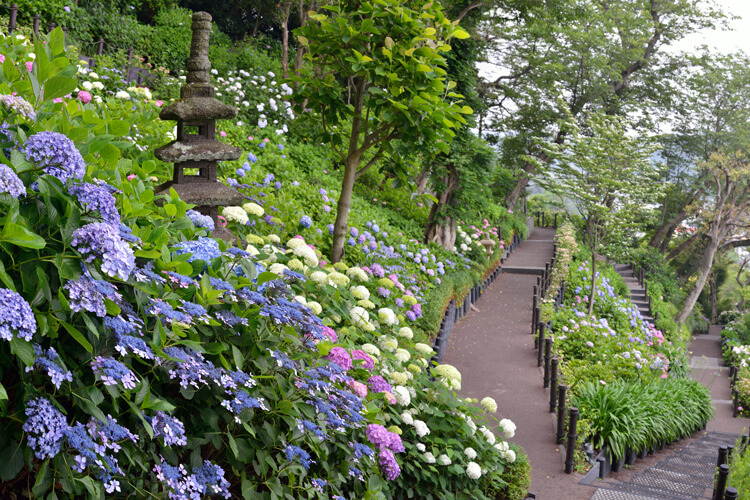
Prospect Path
This path turns into the "Hydrangea Path" in June during the raining season, when hydrangea flowers come to bloom. The path offers more than 40 kinds of hydrangea flowers and a splendid view.
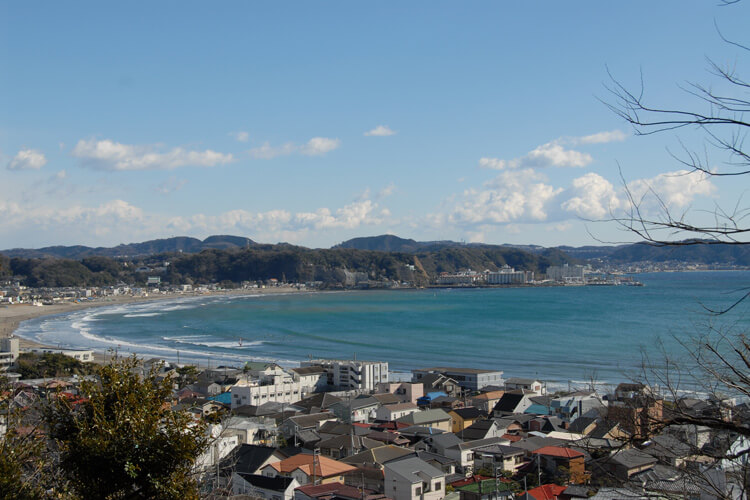
Prospect Path
This path turns into the "Hydrangea Path" in June during the raining season, when hydrangea flowers come to bloom. The path offers more than 40 kinds of hydrangea flowers and a splendid view.
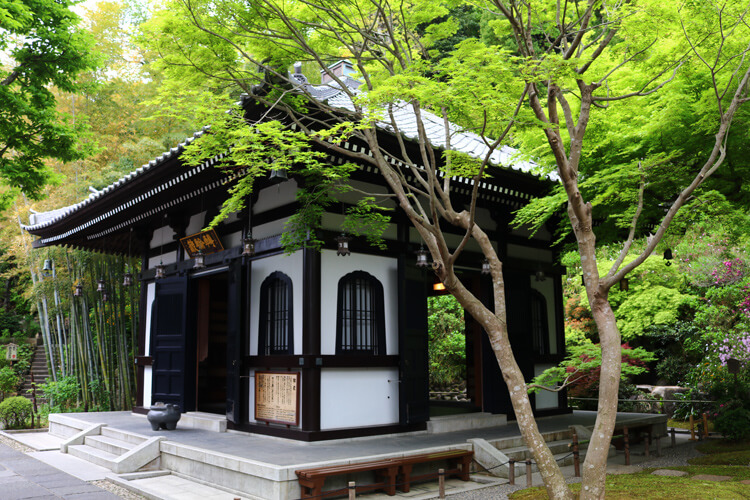
Kyozo
Kyozo is a repository for storing Buddhist scriptures. Such as visitor’s shakyo (hand-copied sutra) can be added to the Kyozo files where they are stored for a very long time. Hasedera’s Kyozo also places Rinzo inside, which is a rotary bookshelf for scriptures. It is believed that when you rotate the Rinzo once, you will receive the same virtue as when you recite all scriptures stored inside. The Rinzo bookshelf can be turned on the 18th of every month, January 1st – 3rd, April 8th and August 10th.
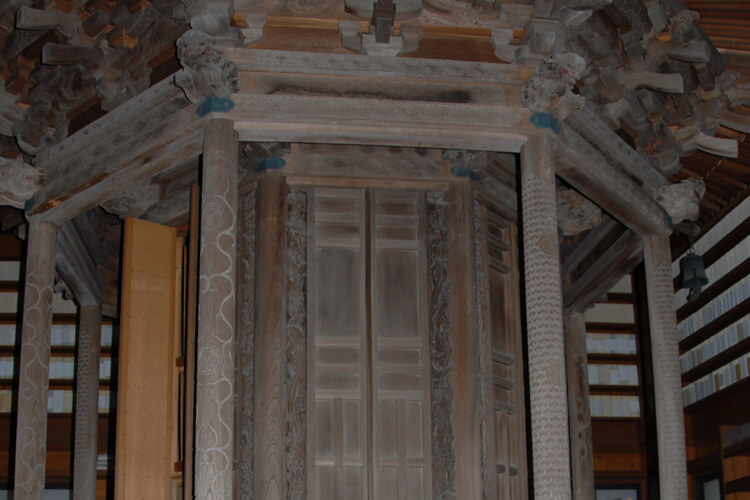
Kyozo
Kyozo is a repository for storing Buddhist scriptures. Such as visitor’s shakyo (hand-copied sutra) can be added to the Kyozo files where they are stored for a very long time. Hasedera’s Kyozo also places Rinzo inside, which is a rotary bookshelf for scriptures. It is believed that when you rotate the Rinzo once, you will receive the same virtue as when you recite all scriptures stored inside. The Rinzo bookshelf can be turned on the 18th of every month, January 1st – 3rd, April 8th and August 10th.
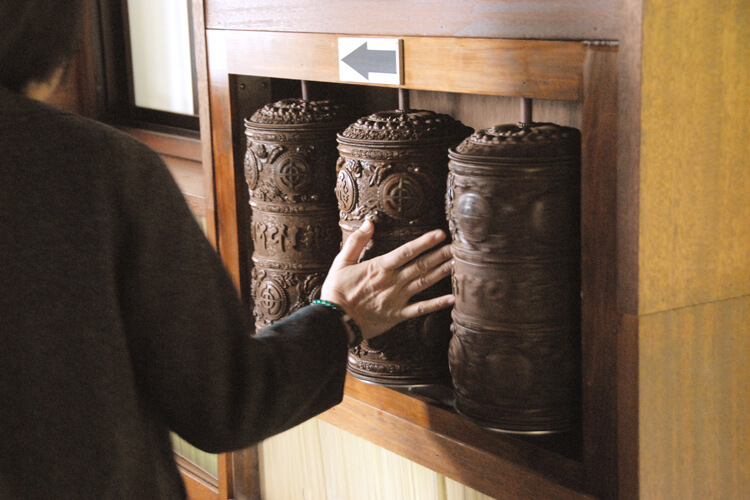
Kyozo
(Prayer wheel) Prayer wheels or Mani wheels are religious implements used in Tibetan Buddhism. It is believed that when you turn these you can receive the same virtue as when you recite the sutras stored inside the cylinders.
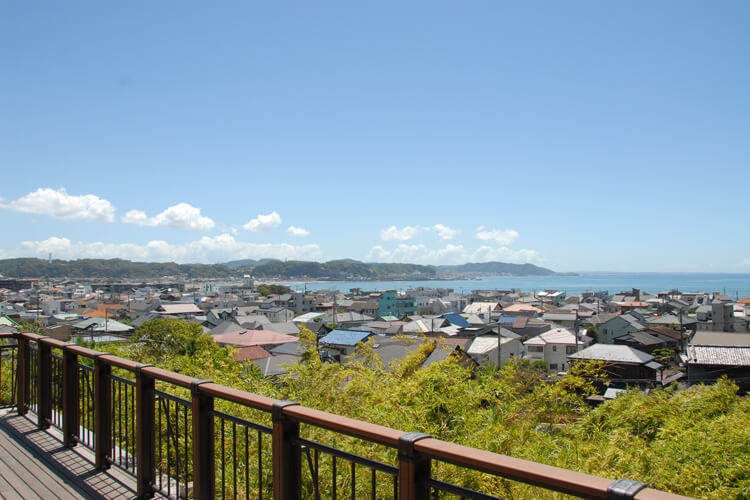
Observation Platform
This observation platform overlooking the townscape of Kamakura and the ocean is known as one of the best view points in Kamakura. Tables and chairs are offered for visitors to relax and enjoy their time.
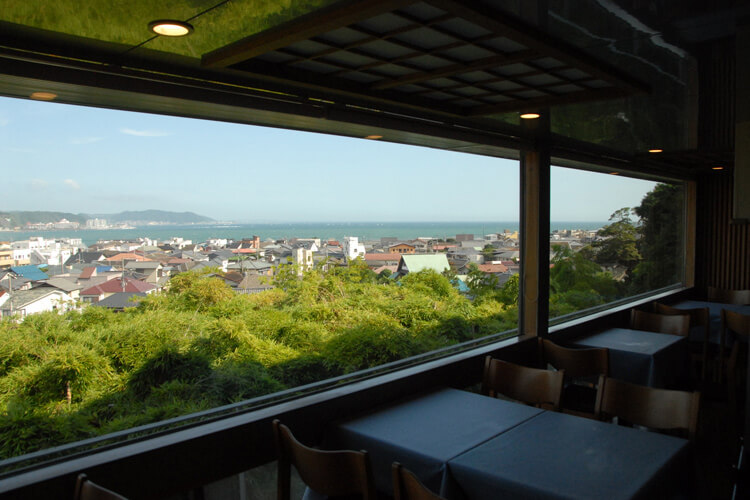
Kaikoan
Kaikoan is a restaurant located in the Hasedera temple. You can enjoy meals and a panoramic view of the sea from the windows at the restaurant.

Kaikoan
Kaikoan is a restaurant located in the Hasedera temple. You can enjoy meals and a panoramic view of the sea from the windows at the restaurant.
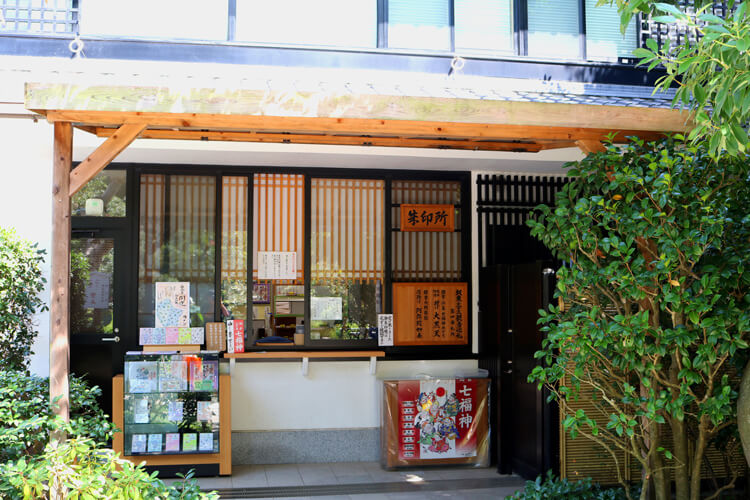
Shuin-jo
Shuin-jo is a place to receive go-shuin stamps. It can be found on the
left side right after the entrance.
→ What is
go-shuin?
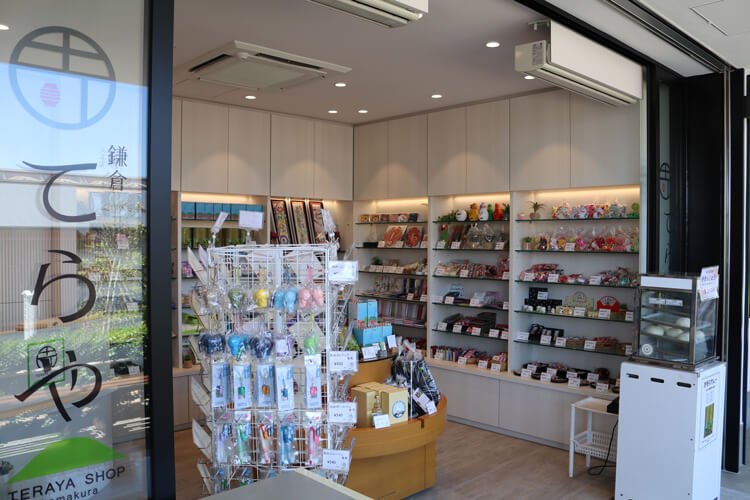
Teraya Shop & Cafe
Teraya Shop, which is located before the entrance, on the corner of the ticket office offers various items such as Hasedera’s special souvenirs, goods and confectionery. Teraya cafe is next to the shop, welcoming visitors as well.
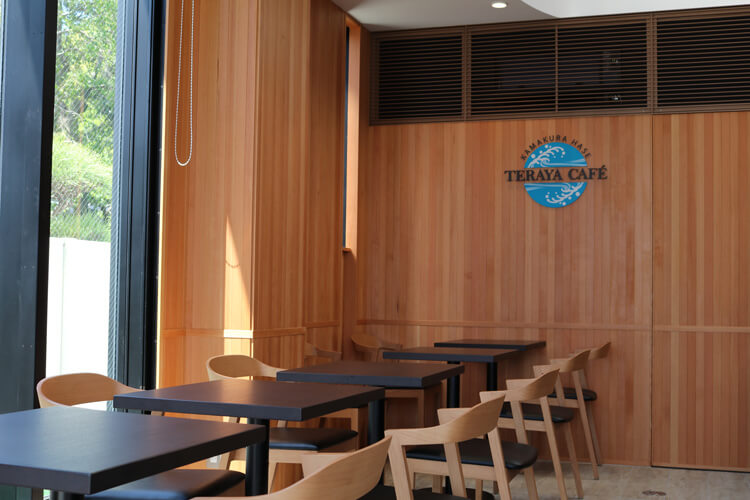
Teraya Shop & Cafe
Teraya Shop, which is located before the entrance, on the corner of the ticket office offers various items such as Hasedera’s special souvenirs, goods and confectionery. Teraya cafe is next to the shop, welcoming visitors as well.
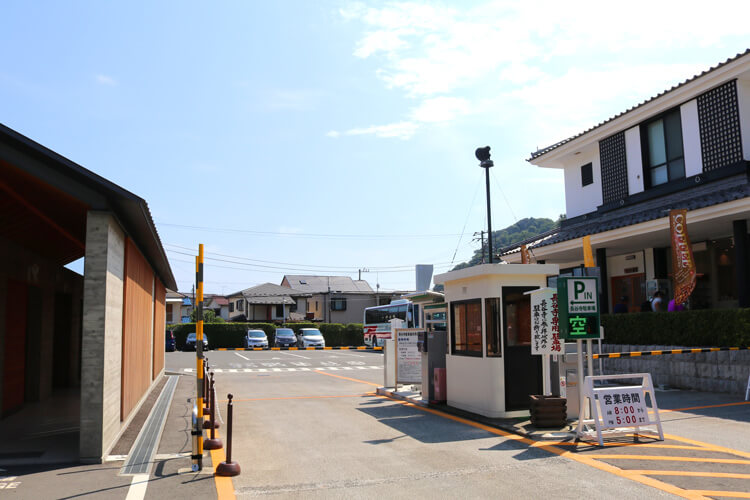
Parking
Parking is available for up to 30 passenger cars and 4 large-sized buses. Reservations are not accepted.
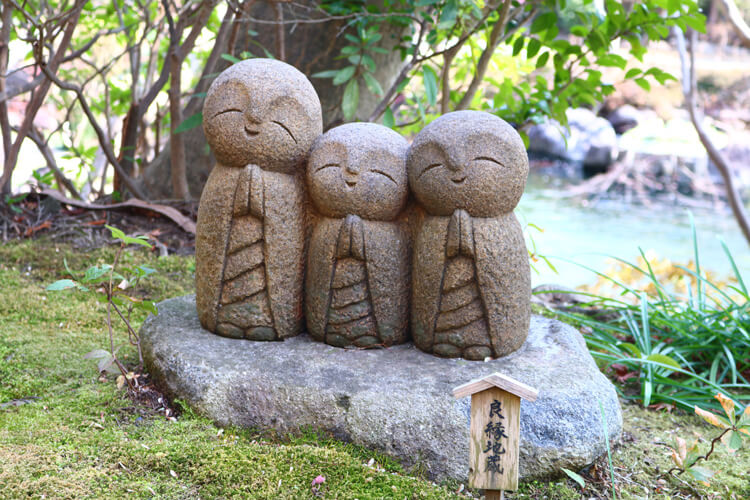
Ryo-en Jizo
Ryo-en Jizo is a group of three little Jizo statues, which visitors can find in three different locations within the Temple.
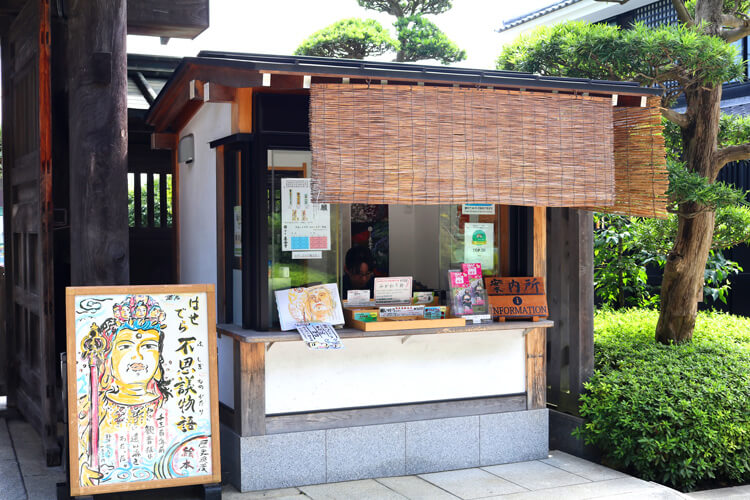
Information Desk
The information desk can be found after the entrance. Visitors are welcome to come here for any questions.
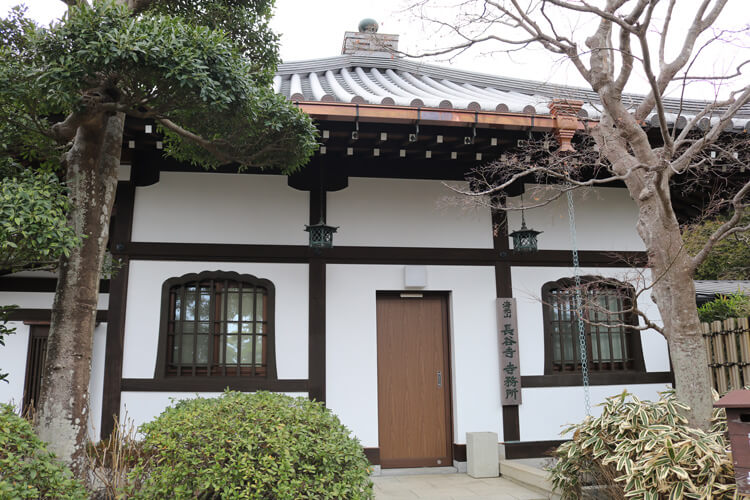
Administration Office
The office can help visitors with general inquiries about visiting the temple.
